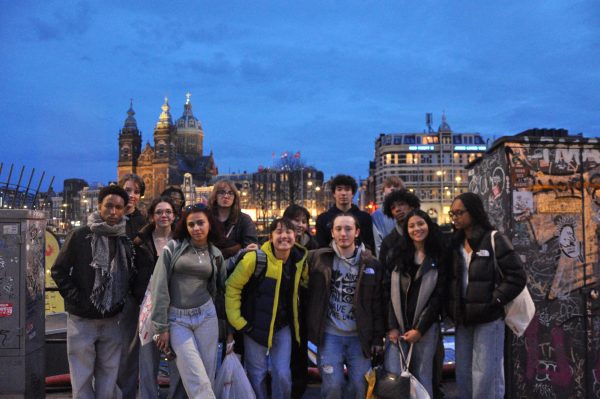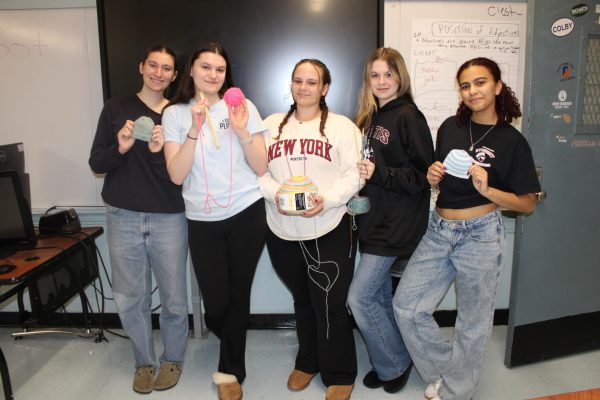What’s it like going back to school?
To say that this past year and a half has been unnerving would be the understatement of the decade. Remote learning has never been implemented on such a large scale before, and adjusting to learning in an online setting was an experience. However, as the city rushed to reopen schools for the 2021-2022 school year, there has been a return to normalcy with coming back to school in-person, 5 days a week. With this return comes conflicting thoughts about the transition, with some ecstatic to go back while others have some caveats about it.
Salma Aletris, a senior, had an interesting experience during quarantine. “I went back to Egypt last year and it was better for me because I got to see my family and friends again back home.” On whether or not the transition back to in-person was easier or harder than she thought it would be, she said “it was normal. I have to wake up earlier and study harder for my exams now. I like my schedule though and the teachers are kind.” She also said that “it’s good though that I get to see them (my friends) in person again,” but she expressed that she liked the remote experience better.
Another student, Xia Jie Ou, a junior, is happy to be in school again but acknowledged that it had some limitations. “The best part is that I can concentrate more and the worst part is that I procrastinate more. It was easier to manage the work in remote learning because you have more time to get work done. I dont have much time in the day to do more. But I like getting to see my friends.” When we asked what he was looking forward to this year, he said that “I’m looking forward to socializing more because I don’t talk a lot, I’m a bit of an introvert. It’s going to get me to socialize more,” and expressed that “In-person is better because I have a reason to go out now. I stayed home a lot during online classes.”
Freshmen, especially, are some of the hardest hit by the rippling effects of the pandemic. Along with the sophomores, not only do they have to face learning how to navigate high school, but also being in the building for the first time.
For Iqmat Adesina, a freshman, the transition has been pretty easy except for the fact that “some days, it still feels like it’s summer. It can be hard to feel motivated.” She went on to explain that “At first it was really stressful coming to a new school since I live far from Curtis, so I didn’t know many people here but then it became whatever because now we’re all kinda close.” Her experience as a freshman has been pretty enjoyable so far, but it’s a new experience as adjusting to high school usually is. “Academically, it’s been different [than remote] because so many teachers worked asynchronously, so you did your own thing and then you just gave it to them. But now, it’s like ‘you have to get it done by this time and then give it to me‘. Freshman year has been so weird for me because everything feels so big. Going place to place makes me feel like I’m going to get trampled.”
For some teachers, the transition back has been bumpy but mitigated by the exciting prospect of getting to do in-person lessons again. Ms. Jackson, a physics teacher, was overjoyed to come back. “I’m very very happy. I missed seeing students and it’s challenging when kids feel scared to speak up online. I did breakout rooms all the time because it was more likely that people would talk in small groups.” As a science teacher, it also felt amazing to do in-person labs again. “People are doing labs instead of watching a simulation. It’s huge to see science happening in real time. I could show you a simulation but it wouldn’t mean as much.” However, there were some challenges. “Last year was crazy but my classes were really small and Wednesdays were spent at home. Now I have full classes again and we don’t have a lot of teachers, so a lot of people (including myself) are teaching 6th period which means more stuff to grade. I’m more tired than usual, but the trade off is absolutely worth it.”
Mr Williams, a precalculus and Theory of Knowledge teacher, was also happy to see all the Warriors come back to school. “It felt weird in the Spring when we only had 100 people on the football field. It didn’t feel like Curtis, but now it feels like Curtis. It feels a little too much like Curtis sometimes with the rambunctiousness.” In regards to how things have changed from last year, he says that “I definitely lost interpersonal skills like making eye contact and stuff like that. At the same time, I turned to journals more and now I’m checking them way more than I used to. So now I’m keeping in touch with students who are stressed out like going through breakups and working jobs outside of school. I know more stuff than I would have ever known before.” One interesting thing he noted was how conversations in his classroom took shape online, and even new things he picked up during remote learning for in-person classes. “In online, you see that happen in the chat. If you got a conversation going that heated people up, you would see the chat fire up. I kinda treated the chat as a sort of parallel classroom. Chat was really good because quiet kids would start to unload in the chat. I love doing jamboards where students would throw interesting ideas on there. I had less control of that, and as a teacher it’s hard to do that because you believe that students would go crazy if you did, but it was worthwhile.” One challenge for him is, ironically, technology, which is definitely used more heavily in school now. “In my head, if I made a pie chart, at least half of the time I spend right now is figuring out what my new passwords and logins are.”
Among all this, it’s important to remember the current mental health situation surrounding quarantine. Luckily, our school has a health center to mitigate the negative effects of being at home for so long. Cassedy Lucas, one of the mental health social workers in the health center, said “I think there’s always been a lot of kids [coming to the health center], but there’s been an uptick in crisis situations involving anxiety and panic attacks.”
While this is worrisome, the health center has a lot of things to combat this rise in mental health concerns. “We offer virtual or in-person meetings weekly or biweekly depending on need and meetings with psychiatrists. We also offer referrals to services outside the school, and family therapy/in-home therapy if requested. I think a common misconception is that we’re DOE, and while we do work within their system, we work with Children’s Aid primarily so we have a lot of resources.”
Although, just like everything else, the health center had to change a lot to accommodate COVID-restrictions, they still remained open through remote learning. “For a lot of things, we had to switch to a virtual model. But we would work in our community or even help people down at the ferry sometimes. When we went hybrid, sometimes we were at school or at home. Students could come to the Health center and set up virtual sessions too if it was hard to get privacy at home. There’s a need for mental health and medical services everywhere since opening back up.” But despite all the changes, she was glad to be back fully in-person and believed it spelled good news for those looking for help. “I think just being in the presence of another person is just healing, especially coming out of isolation, so I think in-person services can be more helpful.”
While this transition period has definitely had its ups and downs, it seems like we’re all getting back in the routine of waking up every morning and heading to school. Love it, like it, or hate it, it seems as though in-person learning is here to stay so long as COVID numbers keep falling.





